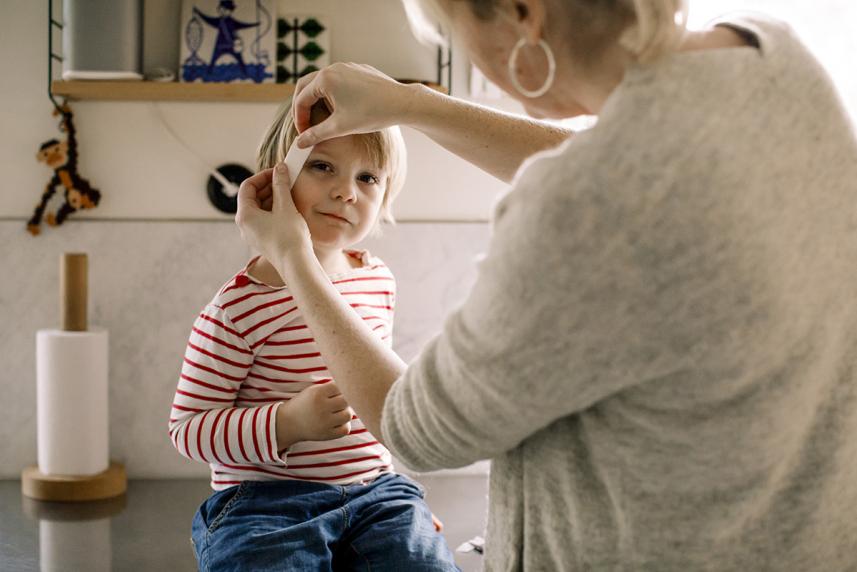Your home first-aid kit checklist for spring
7 minute read
Be prepared for the season’s common mishaps — sprains, rashes, burns — with these essential items.
Jennifer Howze

By Jennifer Howze
Published March 2, 2022
Ah, spring! That time of year when the birds are chirping, trees are budding — and ankles are aching from the season’s first tennis match. Not to mention the fact that you’re itchy from your first hike in the woods. And your child just skinned their knee on the sidewalk.
While it’s great to emerge from a cold, dark winter and get out and play in the great outdoors, you want to be ready to react quickly to medical mishaps so that you can keep the fun going. Now is the perfect time to ensure that your home first-aid kit is ready for whatever comes up.
What to think about when planning a spring home first-aid kit
Your spring home first-aid kit should contain the basics (see our 3 checklists below), plus items that correspond to the specific risks of your favorite spring activities and your personal health conditions. Generally, that includes outdoor activities, allergies and exposure to environmental hazards, says Garry Choy, MD. He’s the deputy chief medical officer of clinical systems in the office of medical affairs at UnitedHealth Group. Here's a recap:
- Self-inflicted activity risks: Cuts and bruises from sports such as biking; sore muscles and sprains from sports such as jogging and stand-up paddleboarding; burns from barbecues.
- Outdoor environmental risks: Plants you may encounter while camping or hiking that can cause rashes or cuts; prickly things in the grass you play Frisbee on; bee stings and dog bites.
- Allergy risks: Tree and grass pollens start up in March in some parts of the country. Weed pollen starts in April.
Shop for home first-aid essentials at the Optum Store, including OTC medications, bandages and more. And have it all delivered to your door.
What does everyone need in a home first-aid kit?
You may have the basics and your own personal needs covered — bandages, antibiotic ointment, gauze — but check out our list to see what items you might have overlooked. And remember: Many of these items can be purchased with funds from a flexible spending account or a health savings account.
Washes, creams and ointments
- Sterile saline or wound wash. Use this to rinse wounds to prevent bacterial infection. “Cleaning the area with a wound wash is helpful before putting an antibiotic ointment on it, especially if it’s on a kid who’s playing outside,” says Daniel Breisch, PharmD. He owns the Mountain View Pharmacy in Bountiful, Utah.
- Antibiotic cream or ointment. This topical can help protect against infections on scrapes, insect bites, cuts and animal bites. An antibiotic ointment, such as Neosporin®, is good for kids because it can include a pain-relief ingredient as well.
- Hydrocortisone cream. This is great for itching, redness, swelling on the skin from insect bites, rashes and other irritations.
- Poison ivy cream. If you live in an area with a lot of poison ivy, poison oak or poison sumac, consider including a cream specifically formulated to treat it, such as Ivarest Poison Ivy Itch Cream®.
- Calamine lotion. Calamine is good for calming itchy and inflamed skin from bites and stings, hives, and blistery rashes from poison ivy, oak and sumac.
- Aloe vera gel. Keep aloe on hand for burns and irritated skin.
- Petroleum jelly. This go-to keeps wounds moist and to moisturize dry skin, cracked heels and dry lips.
- Eyewash. Use eyewash to flush out foreign objects and sooth irritated eyes.
- Sunscreen of SPF 15 or higher. Sun protection is essential no matter what season it is. Shop the Optum Store’s selection of broad-spectrum sticks, creams and sprays.
Bandages and cleaning
- Adhesive bandages. Having a variety of sizes helps ensure that you can cover injuries on fingers, elbows or just about anywhere else. (You'll also want butterfly closures — narrow adhesive bandages that can be used instead of stitches to close a deep cut, also called Steri-Strips®). They’re also helpful to have on hand for cushioning blisters from those new running shoes you’re breaking in. And kid-friendly prints can make the boo-boo a little less painful.
- Gauze. These pads can dress wounds, burns and blisters. They can also be used as a sterile eye dressing to keep an eye wound clean and protected until you can get medical help.
- First-aid tape. You need this to hold gauze and bandages in place. A hypoallergenic paper tape will be gentle on skin and nonirritating.
- Moleskin. This cushioning cover can protect blisters.
- Sanitizing wipes and hand gel. Most people have these around due to the pandemic. They clean wounds, but you can also use sanitizing wipes to sterilize instruments such as tweezers and to keep hands clean when dressing wounds.
Tools
- Tweezers. To pull out splinters, gravel and other foreign objects.
- Digital thermometer. You can get thermometers that measure temperature at the temple or forehead, in the ear, under the tongue or with no contact whatsoever.
- Instant cold packs. These help reduce bruising and swelling from bumps and sprains.
- Nonlatex disposable sterile gloves. For administering first aid cleanly. (Nonlatex ensures that folks with a latex allergy can also use them.)
Medications
- Prescription medications that you may need at a moment’s notice. These include inhalers, asthma medications and auto-injectors of epinephrine. (By transferring your prescriptions to the Optum Store, you may be able to save money. Plus, you can avoid a trip to the pharmacy by having medications delivered to your door.)
- Pain relievers. These include ibuprofen (Advil®, Motrin) for treating pain and inflammation, and acetaminophen (Tylenol®) for treating pain. Those with stomach issues may do better with acetaminophen, rather than ibuprofen. (Only give these medications to those who are at least 6 months old. And before giving children any pain medication, check with the doctor.
- Aspirin. Aspirin can be a potentially life-saving treatment for a heart attack. But it should be avoided by those who are allergic to it, as well as those with bleeding problems or anyone who is on a blood-thinning medication. And never give aspirin to children 18 or younger.
- Electrolyte rehydration solution. Rehydrating solutions, such as Pedialyte®, help replace fluids and electrolytes. Electrolytes such as sodium, potassium and magnesium help regulate the fluids in your body and are important for maintaining good health. Electrolyte levels can get out of whack if you exercise or sweat intensively — or because of vomiting and diarrhea.
- Antihistamines. “It’s always important to have a good antihistamine,” says Breisch. These treat not just the allergies from blooming plants and trees but also skin reactions to poison ivy. Diphenhydramine (Benadryl®) is the go-to oral antihistamine for allergic reactions. Keep in mind that it may cause drowsiness.
- Zyrtec®, or cetirizine, is also useful. You can also consider Allegra® or Claritin® for daily use for seasonal allergies. (If a person is experiencing anaphylaxis, where the throat closes, call 911 immediately and administer epinephrine, if it’s available. Oral medications work too slowly to be of much use.)
- Antacids. In spring we enjoy a new season of fruits and vegetables, and we cook outside more, mixing juicy burgers with chips and spicy dips and toppings. Antacids and anti-gas medications help ease the discomfort.
- Antidiarrheal drugs. Tamp down upset stomach and diarrhea with Imodium®, Pepto-Bismol® or similar products. Choose tablets, liquid or fast-acting versions that melt on your tongue, depending on what’s best for your family.
Final home first-aid checks for the safest spring ever
Once you’ve got your kit stocked, do these 3 additional things and you’ll be ready to spring into spring:
-
Check the expiration dates on medicines and supplies. “You should make sure your first-aid kit is up to date,” recommends Dr. Choy. That means checking the expiration date on all prescription and OTC medicines. Expiration dates are printed on the bottle, carton or tube: Look for a date followed by the letters “EXP.” Expired medications can be less effective, less potent, have an altered chemical composition or even have bacteria growing in them.
Don’t forget to check your bandages, too, says Breisch. “You have to watch out for the adhesive — it will wear away over time. I always go through my medicine cabinet every 6 months,” he says.
-
Check your immunization status. This is a good opportunity to ensure your inoculations are up to date, says Dr. Choy. That includes your tetanus shot, which protects you from a bacterium that lives in soil (and, yes, on rusty nails) and can sneak into open skin wounds. Although rare, it can cause lockjaw and make it hard to swallow. You need a booster every 10 years, according to the Centers for Disease Control and Prevention.
-
Have emergency contacts handy. Keep a list of emergency numbers in your phone, including your family doctor, emergency services, poison help line and emergency family contacts. Also print out the numbers and place them in the first-aid kit, along with a first-aid manual that details basic emergency care. Now you’re ready for whatever might crop up.
Health simplified
Care from the comfort of home. Affordable medications delivered to your door. Products backed by doctors at everyday low prices.
Additional sources
First aid kit basics: Mayo Clinic (2020). "First-Aid Kits: Stock Supplies That Can Save Lives"
Ibuprofen vs acetaminophen: Cleveland Clinic (2021). "Acetaminophen vs Ibuprofen: Which Works Better?"
Anaphylaxis: Harvard Medical School.(2020). "Epinephrine is the Only Effective Treatment for Anaphylaxis"
Expired medications: Food and Drug Administration (2021). "Don’t Be Temtped to Use Expired Medicines"


